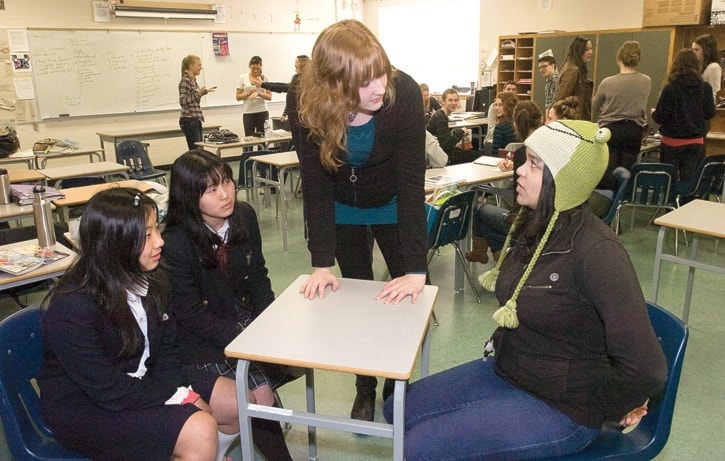When teacher Bev Schellenberg learned of the 9.0-magnitude earthquake and subsequent tsunami that hit Japan March 11, she worried for the Japanese youth who had been corresponding with students at her school.
The Asian teens were participating in the Japanese Canada Cultural Exchange, and planned to travel to Surrey this month to meet their pen pals in person.
Schellenberg, the local co-ordinator of the program, contacted her Japanese counterpart after the quake to ensure the students’ well-being.
“Their co-ordinator said that he would get back to me as soon as he knew all the families were safe,” the Earl Marriott Secondary instructor said. “What was fantastic, was because of email, our students were in contact long before the earthquake. They were able to contact the students who were going to be coming to make sure they were OK.”
And all of them were. What was immediately unclear, however, was whether they would continue with their plans to visit Canada.
“Once I heard about the radiation, I knew, as a parent, that the reality would be it would be better for the students to come than to stay.”
The 22 Japanese students, along with a male and female teacher, arrived in South Surrey April 3 after making brief stops in Ontario and Banff.
The youth were between 14 and 19 years old, and had come from five public schools and one private school in Gunma Prefecture.
Schellenberg said EMS is just one of the bases for the Surrey-wide program, and 19 students from the South Surrey school hosted the Japanese students during their five-day stay.
“They had the Japanese students following them around and attending all their classes.”
The group also went on an excursion to Victoria, where they visited the Royal BC Museum, walked up and down Government Street and tasted a treat from Rogers Chocolates.
The visit ended with a sayonara party at the school April 7, when the English students presented Highland dancing, violin and piano performances and the Japanese students shared their own songs and dances.
“The biggest thing is they get to know another culture extremely well,” Schellenberg said. “Whether we’re referring to the Japanese students or the Canadian students, I think they get a real understanding of homes and how homes run in a different culture and how people interact and educational systems and… how friendships can grow despite language barriers.”
Schellenberg said the meaningful connections students made was evident with the many tears shed last Friday, when the Japanese youth returned home.
“Added to it is just the uncertainty in Japan,” she said, noting a 7.4-magnitude earthquake hit the country the day before their departure.
The current nuclear situation has also been a concern. Schellenberg said she was told of farmers who dumped their crops for fear the vegetables were adversely affected.
Schellenberg said there was a lot to be learned from their experiences, such as how students and teachers handled the March 11 earthquake when it struck during school hours.
“(We were) comparing what they do in an earthquake as opposed to what we do,” she said. “In Gunma, they had windows that broke, walls that cracked, things that fell.”
Schellenberg said one teacher who didn’t have family at home was elected to stay at the school until the last student left.
“She stayed until 8 p.m.,” she said. “As an educator, we have not spoken about that. Who would stay?”
Schellenberg also heard how the schools experienced regular blackouts for about a week after the initial quake. Some lasted hours.
“Our policy in Surrey is the kids stick around for 20 minutes, then leave,” she said. “In Japan, there’s no power anywhere. They had the kids stay in the building with no light.”
The Japanese students expressed gratitude to their Canadian peers for their efforts to aid their home country, Schellenberg said.
“It meant a lot to the students and teachers about the amount of support that White Rock and South Surrey is showing, and Canada is showing as a whole, in Japan.”
The two groups will keep in touch during the year before being reunited next April, when the EMS students travel to Japan for the second half of the program, living and attending school in Gunma with their Japanese friends. EMS has sent as many as 100 students on the trip during the exchange’s 36-year history, Schellenberg noted.
“I trust that this will continue to have a long and healthy life because I think the focus is so important – for people to get to know people from other cultures.”
